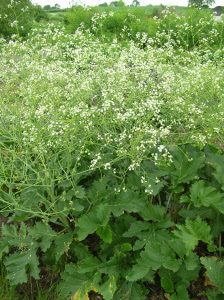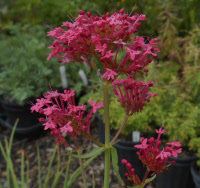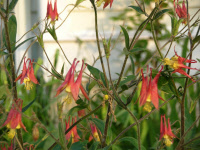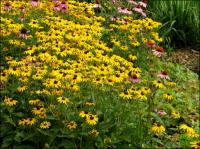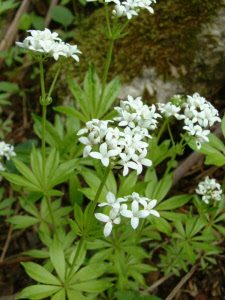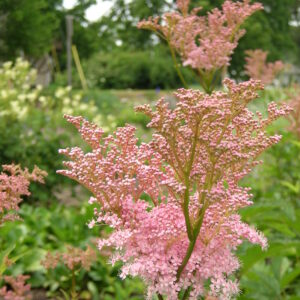Search Results for: bleeding heart vine
-
Crambe cordifolia Colewort Z. 5-9
ARCHIVED Note: This is a plant not currently for sale. This is an archive page preserved for informational use. Giant profusion of white flowers from late May to June...
ARCHIVED
Note: This is a plant not currently for sale. This is an archive page preserved for informational use.
Giant profusion of white flowers from late May to June
Size: 7-8’ x 5’
Care: full sun in well-drained soil
Native: CaucasusFirst collected before 1863. ”This is a stately and noble plant, with large heart shaped leaves. The loose flower-heads, which are often 6 feet in height, and nearly as much through, are composed of myriads of small white flowers, which at a distance may be likened to a giant specimen of Gypsophila; it blooms during June and July.” H.H. Thomas 1915.
-
Centranthus ruber Jupiter’s beard, red valerian, Pretty Betsy Z 5-8
ARCHIVED Note: This is a plant not currently for sale. This is an archive page preserved for informational use. Cluster of crimson, star-shaped florets atop 2’ stems bloom their heads...
ARCHIVED
Note: This is a plant not currently for sale. This is an archive page preserved for informational use.
Cluster of crimson, star-shaped florets atop 2’ stems bloom their heads of ALL summer into fall.
Size: 24-36”x 12”
Care: Sun in well-drained alkaline soil, drought tolerant
Native: Mediterranean
Wildlife Value: attracts butterflies, bees and hover flies.Centranthus is from the Greek meaning “spurred flower.” According to Culpepper, an English herbalist from the early 1600’s, this plant comforts the heart and stirs up lust. Parkinson, in 1629 describes it “of a fine red colour, very pleasant to behold.”
-
Aquilegia canadensis Canada Columbine Z 3-9
May – June, scarlet and yellow columbines...
May – June, scarlet and yellow columbines
Size: 24-36”x 12”
Care: part shade in moist well-drained soil
Native: Eastern Canada to Florida, west to New Mexico, Wisconsin native.
Wildlife Value: Rich, sugary nectar important food for ruby-throated hummingbirds. Buntings and finches eat the seeds. Sole food source for columbine duskywing caterpillar.Seeds are fragrant when crushed, used by Omaha, Ponca and Pawnee as perfume. Pawnee used the plant as a love charm by rubbing pulverized seeds in palm of hand and endeavoring to shake hand of desired person. Crushed seeds also used to cure fever and headaches. Cherokee made a tea for heart trouble. The Iroquois used the plant to cure poisoning and to detect people who were bewitched. Grown by Englishman Tradescant the Elder in 1632. He may have received it from France. Cultivated by Washington & Jefferson.
-
Lavandula angustifolia Lavender Z 5-9
ARCHIVED Note: This is a plant not currently for sale. This is an archive page preserved for informational use. June and rebloom in late summer, lavender spikes, fragrant...
ARCHIVED
Note: This is a plant not currently for sale. This is an archive page preserved for informational use.
June and rebloom in late summer, lavender spikes, fragrant
Size: 2’ x 2’
Care: Sun, well drained moderately fertile soil
Native: Western Mediterranean
Wildlife Value: attracts butterfliesName is Latin from “lavare” meaning to wash because Romans used lavender to scent their baths. Ancient Phoenicians used lavender to make perfume. Cultivated in Islamic gardens by 1050 A.D. Queen Elizabeth, I ate lavender conserve, made by adding sugar to the flowers while Charles VI of France stuffed pillows with lavender and sat on them. Culpepper, 16th century English herbalist, wrote that lavender grew in almost every garden and cured headaches, apoplexy, dropsy, fainting, toothaches, and “passions of the heart.” Jefferson grew it with herbs at his farm, 1794.
-
Iris ‘Spark’ Z 4-8
Early blooming, intermediate bearded iris of brick-red standards and burgundy falls with a bright spark of a beard in the middle.
Early blooming, intermediate bearded iris of brick-red standards and burgundy falls with a bright spark of a beard in the middle.
Size: 23” x 12”
Care: sun in moist well-drained soil.
Wildlife Value: Welcomes bees with easy access to pollen.Iris is named after the Greek goddess who accompanied the souls of women to the Elysian Fields by way of the rainbow. Her footprints left flowers the colors of the rainbow. Iris means the eye of heaven. The iris is the flower of chivalry, having “a sword for its leaf and a lily for its heart.” Ruskin. Spark hybridized and introduced by Col. J. C. Nicholls in 1931,
-
Rudbeckia fulgida Black eyed susan Z 4-9
The classic Black-eyed susan, 3″ wide yellow daisies with a dark center from July – October...
The classic Black-eyed susan, 3″ wide yellow daisies with a dark center from July – October
Size: 30" x 18"
Care: full sun to part shade in moist well-drained to well-drained soil
Native: Southeastern U.S.
Wildlife Value: A great number of bees, flies and beetles collect pollen or drink nectar from this RudbeckiaThis species fulgida was introduced to England in 1760 and named in William Aition’s Hortus Kewensis, V. 3 p. 251 (1789). Cherokee ate the stems and leaves and also used this species to remedy earaches, sores, flux, venereal disease, snakebites, dropsy, and swelling. Iroquois healed the heart and rid children of worms with this, Potawatomi make a brown dye with this.
-
Galium odoratum Sweet woodruff, Bedstraw Z 4-8
Whorls of fine textured leaves, like spokes of a wheel, with white blooms in spring lighting up the shade
Whorls of fine textured leaves, like spokes of a wheel, with white blooms in spring lighting up the shade
Size: 6-12" x 18" spreading
Care: shade to part shade in moist to moist well-drained soil.
Native: Europe and Mediterranean areaCalled “Bedstraw” because, according to legend, Mary rested on hay of Bedstraw on Christmas. May wine made an ancient herbal remedy: handful of dried and crushed leaves plus fresh lemon juice steeped in wine for 3-4 hours “makes a man merry and (is) good for the heart and liver.” Garlands hanging in houses in summer “coole and make fresh the place, to the delight and comfort of such as are therein.” per English herbalist Gerard, 1633. Dried branches give a grassy vanilla fragrance, used in sachets and potpourris, as an insect repellant and to make grey-green dyes.
-
Filipendula rubra Queen of the Prairie Z 3-9
Extraordinary frothy pink plumes, like cotton candy, blooming in midsummer
Extraordinary frothy pink plumes, like cotton candy, blooming in midsummer
Size: 4-6’ x 4-5'
Care: sun to part shade in moist well-drained to moist soil
Native: US East coast west to MN s to MO and NC, Wisconsin native
Wildlife Value: This creates pollen but not nectar limiting the pollinators to bees and flies (Butterflies and wasps want nectar.).Meskwaki Indians used it for heart ailments and as an aphrodisiac. Although the plant’s name has been changed five times, this was 1st described in 1768.

